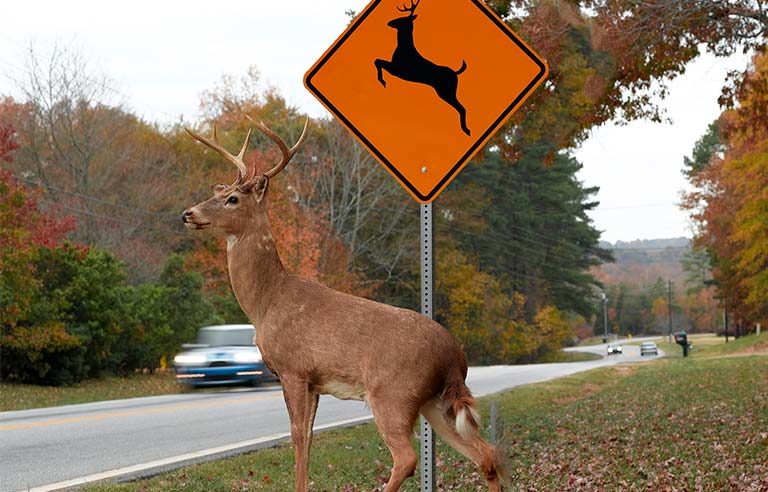Steer clear of deer
Tips for avoiding collisions

Watch your speed
Speed is a major factor in deer-vehicle collisions. When you’re driving during peak movement times of the day or season, slow down.
“Taking speed out of the equation helps decrease the impact of a crash,” Vetter said. “If you slow and still strike the deer, hopefully it does less damage to both the deer and the car.”
Boggess said driving slower also increases your reaction and braking time.
“You’ll be a lot safer at a slower speed,” he said. “It also gives the deer more time to detect you and your direction of travel if you’re going slower.”
Steer or swerve?
When it comes to the decision – often made in a split second – to steer or swerve to avoid hitting a deer, one option is much safer than the other: steering.
In her experience patrolling Michigan’s roadways, Vetter has found that more fatalities occur when drivers swerve off the road.
“We recommend people do not swerve,” she said. “That’s where we see the most fatalities, when somebody leaves the roadway and overturns or strikes another object, like a tree, a fence, a guardrail or another vehicle. That’s where we see the most damage.”
Vetter’s advice? “Steer through the collision. The deer will move and might not survive, unfortunately. If you swerve and hit a tree, the tree doesn’t move.”
If you do strike a deer, Vetter says to stay in your vehicle and call 911. This will help keep you safe from passing vehicles.
Don’t approach an injured deer. “They can be unpredictable, especially when they’re injured,” she said. “They can charge. They can cause a lot of injury if they attack.”
Myths debunked
You may have heard that honking your horn, flashing your lights or using deer whistles attached to your front bumper will help deter deer from running onto the road. Boggess and Vetter agree that none of those is a trusted method.
Flashing lights may cause deer to stop in the road. “We’ve all heard the saying, ‘a deer in the headlights,’” Boggess said. “That frozen stare.”
Noise from your car horn or a whistle will startle a deer, and Vetter said that could cause the animal to dart across the road rather than back into the woods. “There’s no way to predict what they’re going to do,” she said.
Boggess said the most promising research focuses on the use of rear-facing LED bars, which light up the entire front of your vehicle during low-light conditions, making it more visible to deer. In July 2020, the U.S. Department of Agriculture’s Wildlife Services program announced it had applied for a patent for the device after completing a study.
The device can be used in addition to headlights, which deer often don’t see well.
“They see shining bright lights, but they’re just small dots that they see,” Boggess said. “Light bars are lighting up the entire front of your vehicle so it can be seen by the deer as an object coming toward them.”
Post a comment to this article
Safety+Health welcomes comments that promote respectful dialogue. Please stay on topic. Comments that contain personal attacks, profanity or abusive language – or those aggressively promoting products or services – will be removed. We reserve the right to determine which comments violate our comment policy. (Anonymous comments are welcome; merely skip the “name” field in the comment box. An email address is required but will not be included with your comment.)
